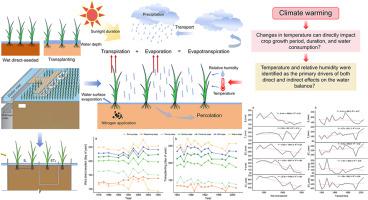Impacts of climate change and water–fertilizer management on water balance dynamics in transplanting and direct–seeded paddy fields
引用次数: 0
Abstract
Climate change and alterations in water and fertilizer management exert profound impact on water balance of paddy fields, posing uncertainty regarding the sustainability of rice production. This study investigates the interplay between climate change and water and fertilizer management on the water balance of paddy fields, aiming to ensure sustainable water use and agricultural production security. Utilizing a 24-year experimental dataset (1978–2001), the study examines the effects of climate variability and management strategies on water balance parameters. The independent variables included in this study were water surface evaporation, effective rainfall, wind speed, sunlight duration, relative humidity, average temperature, maximum daily temperature, minimum daily temperature, minimum relative humidity, average water vapour pressure, accumulated temperature, water depth, and nitrogen application. Advanced statistical techniques, including grey relational analysis, path analysis, and principal component analysis, were employed to assess the impacts of independent variables on water consumption, evapotranspiration, percolation, transpiration, and evaporation. This research focuses on two cropping modes: water direct–seeded mode (WDM) and transplanting mode (PM). The grey relational analysis demonstrated that climate change, and water–fertilizer management, had differing effects on various water balance parameters. Path analysis revealed that temperature and humidity had the greatest direct and indirect effects. Principal component analysis grouped the variables and found that the significant factors under WDM influencing PC1 included maximum daily temperature, minimum daily temperature, nitrogen application, average temperature, wind speed, and relative humidity, which collectively accounted for 39.6 %. The significant factors affecting PC1 under PM included relative humidity, minimum relative humidity, effective rainfall, sunlight duration, and average water vapour pressure, which together accounted for 30.1 % of the total variation. The findings of this study indicated that water surface evaporation, accumulated temperature, and water depth played a relatively minor role in influencing the water balance of paddy fields across both cropping modes. This research contributes to the advancement of climate–smart agriculture, emphasizing the conservation of water resources while striving for optimal yields.

气候变化和水肥管理对定植和直播稻田水分平衡动态的影响
气候变化和水肥管理方式的改变对水田水分平衡产生深远影响,给水稻生产的可持续性带来不确定性。本研究旨在探讨气候变化与水肥管理对水田水分平衡的相互作用,以确保水资源的可持续利用和农业生产安全。利用一个24年的实验数据集(1978-2001),研究了气候变率和管理策略对水平衡参数的影响。自变量包括水面蒸发量、有效降雨量、风速、日照时数、相对湿度、平均温度、最高日温度、最低日温度、最低相对湿度、平均水蒸气压、积温、水深、施氮量。采用灰色关联分析、通径分析和主成分分析等先进的统计技术,评估了自变量对耗水量、蒸散发、渗滤、蒸腾和蒸发的影响。本研究重点研究了两种种植模式:水直播模式(WDM)和移栽模式(PM)。灰色关联分析表明,气候变化和水肥管理对各水分平衡参数有不同的影响。通径分析表明,温度和湿度的直接和间接影响最大。主成分分析对各变量进行分组,发现WDM下影响PC1的显著因子为最高日气温、最低日气温、施氮量、平均气温、风速和相对湿度,合计占39.6%。PM下影响PC1的显著因子包括相对湿度、最小相对湿度、有效降雨量、日照时数和平均水汽压,共占总变化量的30.1%。研究结果表明,两种种植模式下,水面蒸发量、积温和水深对水田水分平衡的影响相对较小。这项研究有助于推进气候智能型农业,强调在争取最佳产量的同时保护水资源。
本文章由计算机程序翻译,如有差异,请以英文原文为准。
求助全文
约1分钟内获得全文
求助全文

 求助内容:
求助内容: 应助结果提醒方式:
应助结果提醒方式:


